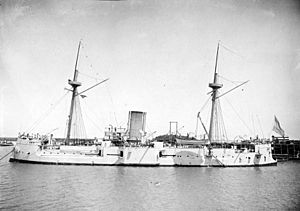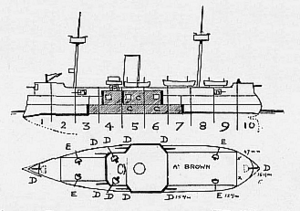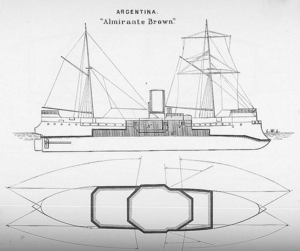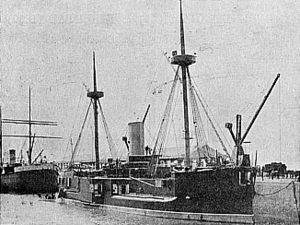ARA Almirante Brown (1880) facts for kids
 |
|
Quick facts for kids History |
|
|---|---|
| Name | Almirante Brown |
| Namesake | William Brown |
| Builder | Samuda Brothers, London |
| Launched | 6 October 1880 |
| Refit | 1897–98 |
| Stricken | 17 November 1932 |
| Fate | Scrapped, 1932 |
| General characteristics | |
| Type | Central-battery ironclad |
| Displacement | 4,200 long tons (4,300 t) |
| Length | 240 ft (73.2 m) (p/p) |
| Beam | 50 ft (15.2 m) |
| Draft | 20 ft 6 in (6.2 m) (deep load) |
| Installed power | 5,400 ihp (4,000 kW) |
| Propulsion |
|
| Speed | 14 knots (26 km/h; 16 mph) |
| Complement | 520 |
| Armament |
|
| Armor |
|
The ARA Almirante Brown was a powerful warship built in London in the 1880s for the Argentine Navy. It was an ironclad, meaning it was a ship protected by heavy armor plates. This ship was quite large, weighing about 4,200 long tons, and could travel at a top speed of 14 knots (about 26 km/h).
It was protected by thick steel armor, up to 9 inches thick, and carried eight powerful breech-loading guns. Almirante Brown was one of the first big warships in the world to use steel armor. For over 15 years, it was the biggest ship in the Argentine fleet! The ship had a mostly peaceful career. By the 1920s, it became a coastal defense ship. It stayed in service until the early 1930s and was later taken apart for scrap.
Contents
Ship Design and Features
How the Ship Looked
The Almirante Brown was 240 feet (73 meters) long. It was 50 feet (15 meters) wide and sat 20 feet 6 inches (6.2 meters) deep in the water. The ship's body was made of steel, covered with wood and zinc. It had a special "double bottom" and a pointed "ram bow" for attacking other ships. The ship also had two tall masts and needed a crew of 520 sailors and officers.
Engines and Speed
The ship moved using two steam engines that turned two propellers. Eight large boilers heated water to make the steam. These boilers were in four separate, watertight rooms. The engines could produce 5,400 horsepower, allowing the ship to reach a top speed of 14 knots (26 km/h). The Almirante Brown could carry 650 tons of coal to fuel its boilers. Besides its engines, the ship also had sails that could be used for extra power or when cruising.
Weapons and Protection
The Almirante Brown had eight large 8-inch Armstrong guns. These guns were "breech-loading," meaning they were loaded from the back, which was a new and powerful feature at the time. Six of these guns were in a central area, and two were at the front and back of the ship.
It also had six smaller 4.7-inch guns on the upper deck. Four were at the front and two at the back. For close-up defense against smaller boats, it carried two 9-pounder guns and two 7-pounder guns.
The ship was protected by strong "compound armor" made of steel. This steel armor was a new invention that helped save weight. The main armor belt was 9 inches thick in the middle of the ship. It got a bit thinner towards the front and back. The central area where the main guns were kept had 8 inches of armor. The deck (the ship's floor) was also armored, and the "conning tower" (where the ship was steered) had 8-inch thick sides.
Ship's History and Service
In 1878, Argentina wanted a new, large warship for its navy. Until then, their navy mostly had smaller ships for coastal and river defense. The Almirante Brown was ordered from a shipyard in London, England. It was launched on October 6, 1880, and cost the Argentine government £270,000.
On June 14, 1881, the ship had its speed tests and reached its planned speed of 14 knots. When it arrived in Argentina, it was the biggest ship in their navy. It stayed the largest for over 15 years! The Almirante Brown was part of the opening ceremony for the new harbor in Buenos Aires on January 28, 1889.
On July 13, 1892, during a big storm, people thought the ship was lost, along with another ship called Rosales. Luckily, both ships survived. The next year, Almirante Brown helped put down a naval rebellion during the Argentine Revolution of 1893.
In 1897, the ship went to a shipyard in France for an upgrade. Its old main guns were replaced with ten new 5.9-inch quick-firing guns. The smaller 4.7-inch guns were also replaced with newer, faster-firing models. The crew size was also reduced to 380 sailors.
By the 1920s, the Almirante Brown was an older ship. It was used for coastal defense and training, as newer, more powerful battleships had been built. On December 17, 1921, some crew members from the ship went ashore to fight a group of about 250 bandits. The ship continued to serve until the early 1930s. On November 17, 1932, the Almirante Brown was officially removed from the navy's list and later sold for scrap.
See also
- List of ships of the Argentine Navy




